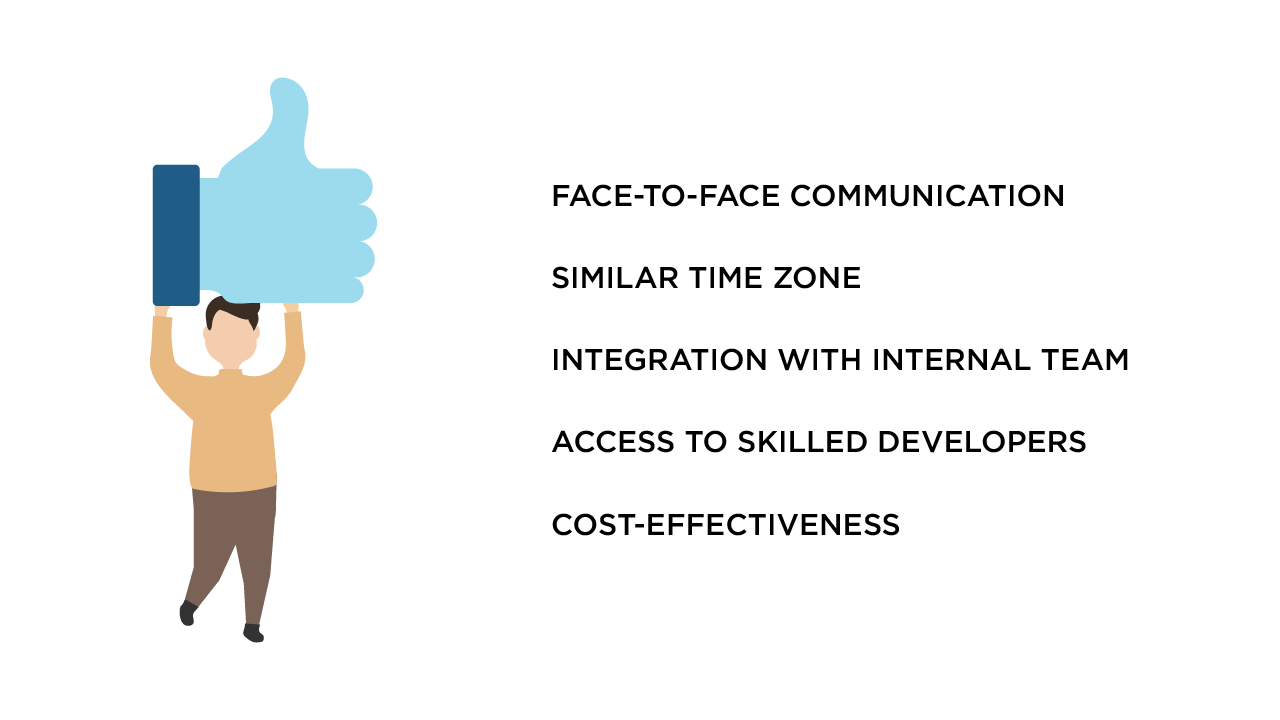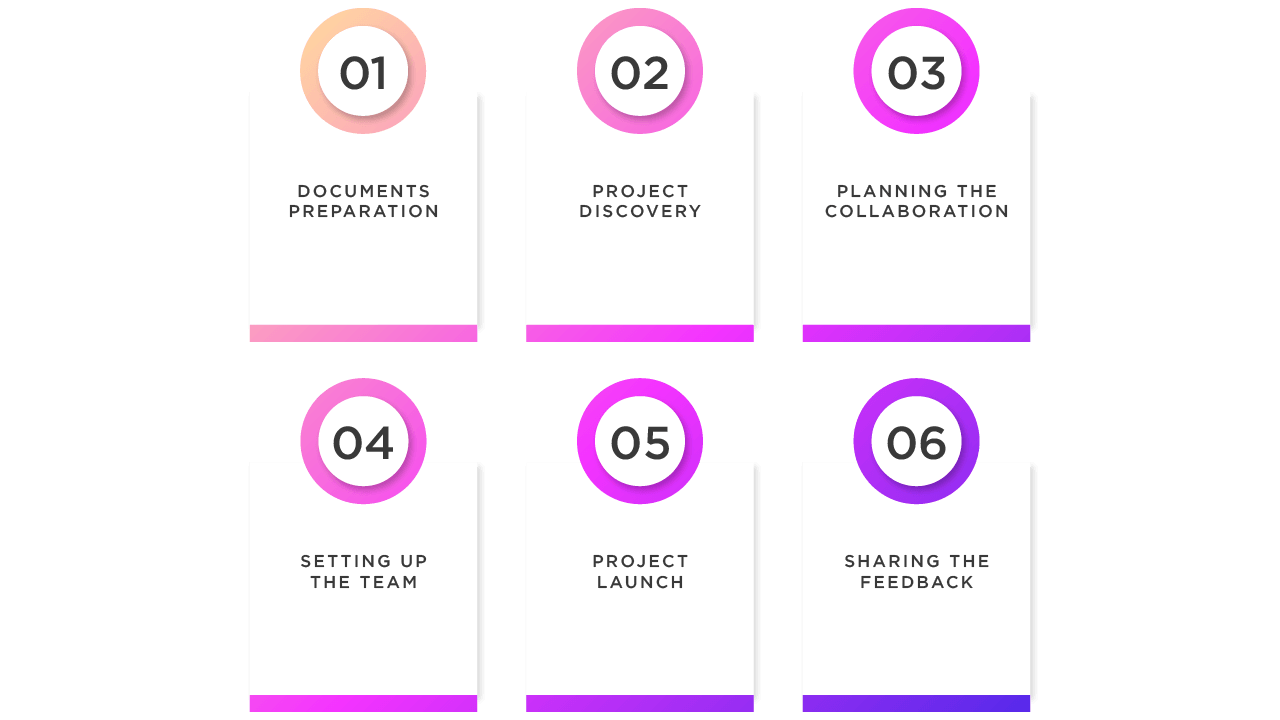Best Practices for Nearshore Software Development

Companies no longer need to keep expensive IT specialists on staff. Thanks to globalization, outsourcing has become the easiest way to expand quickly. There are three common types of software development outsourcing for IT services: offshore, onshore, and nearshore. How can you choose the most appropriate one for your business?
In this article, we will help you to understand what nearshore outsourcing is and if it is suitable for you.
Contents
- What Is Nearshore Software Development?
- Nearshore vs. Offshore
- What Problems Can Nearshoring Solve?
- Advantages of Nearshore Software Outsourcing
- Disadvantages of Nearshore Software Services
- Key Factors to Consider When Choosing a Nearshore Software Development Team
- Best Practices for Nearshore Cooperation
What Is Nearshore Software Development?
Nearshoring is a form of software development outsourcing. It allows companies to delegate some tasks, or even entire projects, to outsourcing companies in nearby countries. Such an approach helps businesses save time and money, have access to an unlimited talent pool, and stay focused on their internal tasks.
When it comes to nearshoring, the time zones, languages, and cultural characteristics of the partner countries are the same. This allows for better communication—a critical factor in every software development process.
Nearshore vs. Offshore
Offshore software development involves outsourcing to distant countries to streamline the hiring and budgeting process. When choosing an appropriate partner, companies usually give preference to countries with a huge talent pool and low hourly rates.
In such cases, time zones play an important role. As partnering companies are located in different time zones, they should have at least a few overlapping hours for calls and online meetings.

One of the main purposes of offshore development is to cut costs while hiring experienced specialists. If you follow the right steps and choose carefully, cooperation with an offshore team can result in building a top-notch product at an affordable price.
Offshore regions are usually located in another part of the globe. For example, a company in India may become an offshore developer for a client in the United States, or Latin America may be an offshore destination for a company in London.
Nearshore outsourcing combines the advantages of both offshore and onshore software development outsourcing, with the low cost of qualified employees on the one hand, and the same timezone, language, and culture on the other.
Nearshoring is characterized by a closer location to the client’s country. In some cases, the time difference between the two countries is more than 2–3 hours, but as long as the developers are relatively close, it is considered nearshoring. This allows for smooth communication and the ability to meet face-to-face if needed.
What Problems Can Nearshoring Solve?
Every company has its reasons for hiring a nearshore team to develop a project. We have collected the most popular of them in the list below.
- Lack of experienced developers—your home outsourcing market is deprived of required specialists and finding them is a real challenge.
- Tight budget—you need to cut costs without compromising on quality.
- Lack of flexibility in your business processes—your company processes no longer help you meet your goals and adapt to growing customer expectations.
- Slow time to market—the pace of launching new products is dragging you down.
- Starting a new business—the software department does not yet exist, or the founders do not have the required
- Implementing a new technology stack—the project requires a different technology that is beyond your team’s expertise.
Advantages of Nearshore Software Outsourcing

Face-to-face communication
One underestimated benefit of nearshore outsourcing is the opportunity to meet with your remote team face-to-face. They are usually located within a 2-hour flight from your company. These in-person meetings with various specialists can give you a more accurate picture of the services they provide and the people you are going to work with. This is because, quite simply, sales managers are often trained to tell you what you want to hear. It can be hard to tell if their words will be backed up by some real action. Only by meeting people and immersing yourself in the outsourcing company environment can you truly understand whether this collaboration will be a disaster or a dream come true.
Similar time zone
You will probably agree that waking up early in the morning to talk to your remote team is nerve-racking. If you have ever managed an offshore development team, you will know what we mean. Hiring a nearshore team allows you to communicate with them during your normal business hours. Not only does this prevent your schedule from becoming irregular, but it also allows your internal team to interact with their external colleagues. Last but not least, holding daily meetings with such a team is as easy as when working with local partners.
Simple integration with your internal team
It often takes outsourcing teams several months to get used to an organization’s processes before they can begin to make something valuable. However, nearshoring brings another key benefit: the remote team will have similar cultural traditions, a common language, and shared technical skills. Quality communication and mutual respect from working with specialists with the same level of expertise allow them to quickly integrate with the existing team.
Access to the most experienced developers
The software development market in the United States has always been highly competitive. Companies—both large and small—have to finesse and spend too much time and effort on acquiring good talent. They have to guarantee relocation, bonuses, or perks to attract them. An often-stated benefit of nearshore development is simply the opportunity to acquire specialists that are not available or are unreasonably expensive in the United States. Being able to find those who work at the same time as your team, have the required technical skills and speak the same language is a great advantage for companies that face such challenges.
Cost-effectiveness
The growing lack of resources has increased the price of a quality workforce and as a result, companies are constantly in search of ways to reduce operating costs and overheads. As such, the biggest advantage of nearshoring is that you can save a lot of money. The fact is that the standard of living in these countries is lower and, accordingly, development rates are also lower. Nearshore companies provide the equipment, facilities, and employees at a lower cost than their onshore counterparts. Despite nearshoring not being the cheapest option, it provides the highest return on investment due to the benefits described above.
Disadvantages of Nearshore Software Services

Higher price in comparison with offshore outsourcing
Despite all the disadvantages of offshore outsourcing, it remains the cheapest option. If there are no affordable developers in your region, you are better off hiring an offshore software development company.
Lack of companies
It may be that neighboring countries are not focused on the development of the IT sector. In that case, you will not find qualified developers there.
There may be IT companies in every country, but what is the quality of their services? Will an unknown company do things better than a company from proven outsourcing countries? If so, we recommend considering offshore companies, but be sure to check the reviews.
The need for periodic monitoring
This is a common drawback for all types of outsourcing. From the moment you hire a team, you need to periodically contact them and monitor the process. Fortunately, holding meetings with nearshore countries is easy; for example, we at VironIT always try to organize video conferences with customers at a convenient time for them.
Key Factors to Consider When Choosing a Nearshore Software Development Team
By giving preference to a nearshore team, you can access the talent with the most appropriate knowledge, skills, and tools. You will be able to choose specialists who have experience in developing similar solutions in your field.

Do they have relevant experience?
Knowledge of technologies they have already worked with does not necessarily make a team experienced. It is important to conduct a detailed analysis of all the appropriate developers and decide which team provides the best quality of service. A true indicator of experience is if the team has carried out real projects in your field and has a proven track record of solving similar problems. Look for skilled developers with years of experience first. Both experienced and novice managers offering up-to-date training and ideas would be an advantage.
Can they meet all of your requirements?
We know that the cheapest option always seems attractive at first. But you need the team that is best prepared to achieve your business goals. The beauty of nearshore software development outsourcing is that you gain access to a potentially huge pool of talent with a variety of skills. Consider factors that indicate a proven provider for you, such as effective communication, expertise in your industry, scalability, a diverse range of technologies, and a strong portfolio.
Do they hear you?
Of course, hiring a remote team means choosing talent from anywhere in the world. Nevertheless, you should remember that other countries have different time zones which can result in poor communication. It is important to provide a clear overview of the project objectives, as this directly impacts the success or failure of the project. To prevent any misunderstandings during the development process, we recommend using an Agile methodology.
Are they transparent?
You will need transparency about the work being done by developers. Lack of transparency will result in you not seeing the whole picture. Teams may have multiple projects at the same time as yours, and they may not have the attention and time necessary to complete the tasks on time. Ask if they use any project management tools (such as Trello, Jira, Basecamp, or Asana). These tools allow companies to show their commitment to providing clear communication with their partners. Such instruments will help you have an overview of the project’s progress at each stage. You will see who is responsible for particular tasks and when they are planned to be completed.
Are they flexible?
Like any other complex project, software development usually comes with several challenges. However, with an architecture designed from the beginning, overcoming these obstacles will be much easier. When non-functional requirements—such as scalability, data migration, performance, and security—are taken into account from the beginning, you end up with a more efficient and cost-effective development process.
Are they capable of adapting to changes when needed? Are they able to apply different work practices? Have they used various approaches to software development?
Best Practices for Nearshore Cooperation

Preparation
At this stage, you should evaluate the starting point. Prepare your team to work with a remote team. Make sure that you are ready to discuss the details with the potential partner. Prepare all the necessary documents and specifications and conduct a business analysis. Think about which development stages you would like outsourced. The better you prepare, the faster you will start the process.
Project discovery
After contacting your potential partners, it’s a good idea to sign a non-disclosure agreement. Thus, you will feel safe during the discussion. In any case, you will have to provide your remote team with all the necessary details.
You may also discuss any challenges that may make it difficult for the team to transfer knowledge and adapt. Helping each other at this stage will keep you on track when sharing requirements and setting goals.
Planning
Here, you choose the engagement model. The options are as follows:
- Team extension—the nearshore company provides you with the specialists you require. Your company is responsible for project management and tasks.
- Team delivery—you get a dedicated team of any size that works with the required technologies. The team implements the whole project or any of its specific modules.
- Project delivery—the nearshore company implements the whole project according to the client’s requirements and an estimate agreed upon in advance.
Tell the partner about your preferred model and ask what commitment is required of you. Even if you choose to outsource the whole project, you must be involved in the collaboration. If you are too busy, designate a contact person to handle these issues.
Setting up the team
At this point, be ready to discuss your ideal set of specialists in the future team. A good nearshore company will help you assess the level of skill required. Both overestimating and underestimating are bad ideas at this stage. If developers get tasks that are either above or below their skill level, their motivation may decrease, resulting in team instability.
Project launch
Before the COVID-19 pandemic, launch meetings usually took place in the client’s headquarters. Today, while there is no chance to meet face-to-face, you can still hold a great kick-off meeting online. The key point to remember is to prepare in advance.
Once the call has started, let everyone show their face, briefly introduce themselves and talk about their role in the project. You can also prepare a presentation on the topics to be covered during the conference.
Share the feedback
As you can see, seamless communication is an essential part of nearshore software development. The quality of the final product depends on understanding and trust. To achieve this, the two teams should work together as one.
Remember that honest feedback is vital to building a relationship based on trust. Provide further training to share values and build loyalty to let the nearshore team understand your approach.
Conclusion
If used wisely, nearshore software development outsourcing will only benefit you. Like any business process, it requires a well-thought-out strategy and effective management. It is often easier to try it out on a small trial project to see if this approach suits you. But, if this approach doesn’t suit you, you should follow alternatives to nearshore software development outsourcing. Also, remember that working together from the beginning will help both parties determine what is required for a successful collaboration.
Don’t hesitate to contact us at [email protected] if you have any questions regarding this topic. Let our experts provide you with the help you need.





Comments are closed.